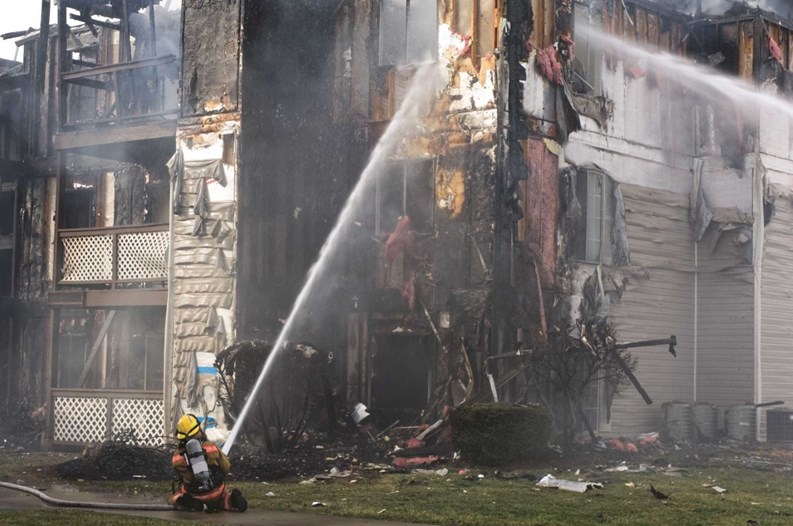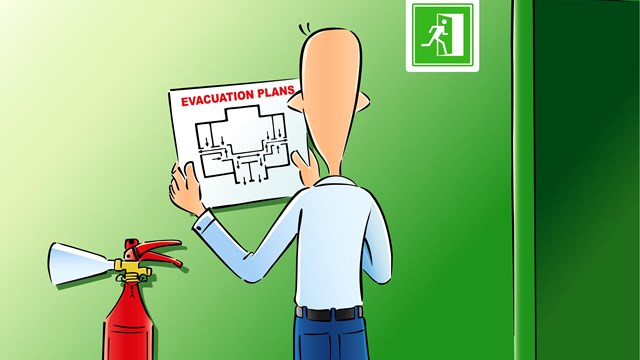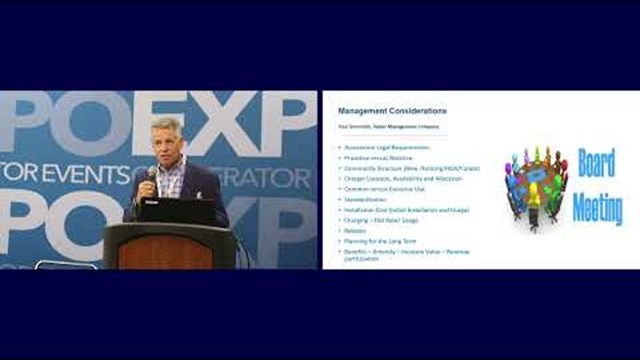One only needs to watch the news regularly to understand the devastation that a fire can have on a home or community whatever the time of year. A condo fire in October in Dunellen injured a firefighter and destroyed much of the complex, leaving many of the residents homeless. Firefighters had a tough time battling the blaze because of hoarding conditions inside the apartment unit, according to news accounts of the event.
Fires can happen any time but certain times of year are more dangerous. “The winter months are the peak time of the year for fire deaths,” says Marty Ahrens, a manager of fire analysis services at the National Fire Protection Association (NFPA), based in Quincy, Massachusetts.
According to a Federal Emergency Management Agency (FEMA) report published last year for the years 2009 to 2011, multi-unit dwellings were responsible for close to 30 percent of all U.S. residential fires serious enough to require a call to the local fire department. Three hundred ninety-five deaths were caused by these fires, 4,250 injuries, and $1.2 billion (yes, billion!) dollars in property loss. It's just plain old common sense to have a solid prevention and evacuation plan and make sure everyone knows the details.
Formulate a Plan
Understanding legal requirements is the first step in developing a fire safety plan appropriate for each association. Most municipalities use some edition of the International Code Council's International Fire Code (IFC). The New Jersey Edition of the IFC is available free online at www2.iccsafe.org/states /06NewJerseyFire/Fire_Code/NJ_Fire_Frameset.html. For help in your own planning, check out Chapter 4, “Emergency Planning and Preparedness.”
Bill Worrall, a vice president with First Service Residential, a nationwide management firm which has offices in Eatontown and Lyndhurst, says his company has a long list of items that building staff and management need to understand when it comes to fire safety. These include the building’s plans and drawings, both electrical and plumbing. They should be on file in hard and electronic format.
Additionally, an adequate fire safety plan should include the location of building fire protection systems; names and phone numbers of those responsible for maintaining the fire protection equipment; names of and procedures for on-site staff responsible for reporting fires, notifying residents, giving emergency medical help and staying to take care of critical systems; evacuation procedures and special instructions for any mobility-impaired residents; and a plan to account for all staff and residents after evacuation.
“Make sure you work with your local fire department on your plan,” says Robert Solomon, a division manager with the NFPA. “They are in the best position to offer ideas on how other buildings handle their plans and if they have any additional protocols, such as how often the residents should be reminded of the plan, or even practice the plan. The building manager should also have a strategy to conduct ongoing inspection, testing, and maintenance actions on the fire protection systems. This would include smoke alarms in the dwelling units, smoke detectors in common areas, manual fire alarm stations, automatic sprinkler systems, and other systems or features that may be present.”
In addition, says Worrall, “You must be aware of the age of your community and how new legislation may require investments in new infrastructure to ensure all buildings are up to code. This is especially true of older developments. Newer communities are typically built to current codes, but it’s still important to conduct an annual review of relevant legislative changes.”
“Since each building is unique, each plan is unique,” says Solomon. For instance, he says, “the escape planning for a low-rise condo unit is very different than the plan for a high-rise unit.” And, he adds, “the NFPA website, www.nfpa.org, offers numerous, readily available and free resources for managers, boards, and residents.”
Worrall outlines First Service Residential’s three-step process for fire prevention. “First, we make sure our rules and regulations comply with local fire codes. Second, we keep our building inspector’s approval on file in the management office. Third, we communicate to our residents any changes to the local laws and changes to our building’s plans on an annual basis.”
Information is Key
Both staff and residents need to know how to cooperate in prevention of fires and in response to an emergency. On-site employees must know their responsibilities, including who checks safety equipment and how often, who calls the fire department, who alerts unit owners, who will have the roster of residents to check when everyone gets to the evacuation point, and so on.
Worrall points out that, “Everyone on staff should also know the schedule for annual inspection by the local fire authorities and know the basic elements of the inspection. Our motto is to be prepared, as opposed to surprised, when the inspector arrives.”
One thing an inspector will check is egress availability. Solomon says, “Housekeeping is important. The exit doors should never be blocked, and corridors and exit stairs, including the landings, should never be used for storage.”
Besides a knowledgeable staff, good communication with residents is critical to an effective fire-safety plan. Residents should be familiar with their means of egress in the event of an emergency. They should also perform monthly checks of their smoke alarms and replace the batteries twice a year when daylight-savings time changes.
Worrall says that First Service Residential communicates the building plan to the residents on a regular, recurring basis, typically annually. It also provides the plan to all new residents as they move in as part of the orientation process.
Where It Starts
Understanding the causes of fires in multi-unit dwellings can help in their prevention. Cooking, heating equipment, smoking, electrical failure, and open flame (matches, lighters, candles) are the most common causes of fires in multi-family housing.
A startlingly high percentage, nearly 70 percent, of fires in HOAs and apartments are caused by cooking. A large proportion of these started when the cooking was untended. Residents were distracted or forgetful or even asleep. According to the National Fire Protection Association, 43 percent of people who have died in cooking fires were asleep at the time.
Association managers or boards might want to communicate these statistics to residents and encourage them to be especially vigilant when cooking. Remain in the kitchen if at all practical and, even if that stew or pot of beans is on a very slow simmer, do not nap.
“Though cooking is the leading cause of fires in multi-family homes, smoking is still the leading cause of home-fire deaths overall, and that's an important distinction,” says Ahrens. “Something else that we are seeing in general is that more and more homes are not allowing smoking inside. I don't know about your neighborhood, but I go out even in the winter and see a lot of people smoking on their balconies or their steps.”
Depending on the structures they control, association management and boards can often make their buildings safer by providing non-flammable containers where residents can discard smoking materials. Ahrens says, “It's really important to make sure that there are safe places to dispose of cigarettes outside—not in the mulch, not in the potted plants.”
A dramatic condominium fire is more likely to make the news than an individual house fire, and such coverage can heighten fear of a conflagration, but you may actually be safer in a multi-family home than in a house. “There is a lower death rate in apartments than in one- or two-family homes. Seventy-one percent of the home-structure fires were in one or two-family homes, but that accounted for 84 percent of the home-structure deaths,” says Ahrens.
One reason is heating systems. “The equipment that is managed centrally is less of a problem in terms of causing fires in multi-family housing than it is in one- or two-family housing. In one- and two-family homes, you're free to a large degree to do what you want,” Ahrens explains.
In addition, says Ahrens, “The codes and the professional oversight play a big role in the multi-family housing.” Regulations that mandate such life savers as smoke detectors do make a difference.
Insurance Needs
Besides saving lives and property, a strong prevention and evacuation plan can save money on insurance.
Debbie Pasquariello, a senior account executive at BHB Insurance Services in Toms River, states, “A risk-reduction plan can significantly aid the association in controlling their insurance costs.” And, “there can be a wide range of rates charged depending on building construction, location, size of the building/s, safety devices (sprinklers, fire doors, etc),” she says.
Cappy Stults, president of the Allen & Stults Company in Hightstown, adds, “Insurers are generally concerned with fire safety, which includes access to water (hydrants), water pressure, fire companies in the area, housekeeping of the grounds and buildings and upgrades of electrical systems and heating systems. Use of generators and cooking grills are also of concern for most insurers.” And of course, as Pasquariello reminds us, “Loss history has a large impact on rates and premiums.”
“All associations are required to carry insurance.” says Pasquariello. However, specific requirements vary.
“The master deed and bylaws specify what property insurance must be purchased,” Stults says, “on what property, in whose interest, to what extent and how damage or destruction is to be handled by the association.
“In general, all condominium documents we have reviewed require all 'condominium property' to be insured to replacement cost. Most state 'to the extent available in the commercial marketplace' or similar wording. This may not automatically include the current cost to replace the buildings to current municipal or state building codes. Increased Cost of Construction/Building Codes coverage is needed to cover this potential added cost,” he says.
Association bylaws stipulate what parts of the structure or structures are covered. “Some documents may mandate that only the common property such as roofs, exterior walls, fixtures and structural elements be insured. Many, however, stipulate the aforementioned including all common elements and unit improvements existing at the time of initial conveyance. Improvements and upgrades made by the owner or any previous owner are the insurance responsibility of the condo owner, not the association. Few but some condo associations may insure said upgrades,” notes Stults.
Another factor that should be considered is deductibles. “Associations have been forced to increase their deductibles over the past many years,” Stults says. “Unit owners need to be informed that they may be responsible for the first $5,000 or more of property losses to their unit. The broker should supply the association with a letter of coverage explanation outlining for the unit-owner what personal coverage they may need.”
Can a management company, board or staff be sued by a resident who suffered losses in a fire?
“A properly designed insurance program will include the board, staff, and property manager as insureds,” Stults says. “Should they be named in a lawsuit arising from a death or injury to a resident or guest, a proper policy will provide defense and damage payments subject to the liability policy limits.” This is true “unless there has been criminal activity or other similar circumstances,” adds Pasquariello.
Keith Loria is a freelance writer and a frequent contributor to The New Jersey Cooperator. Staff writer Judy Hill contributed to this article.







Leave a Comment